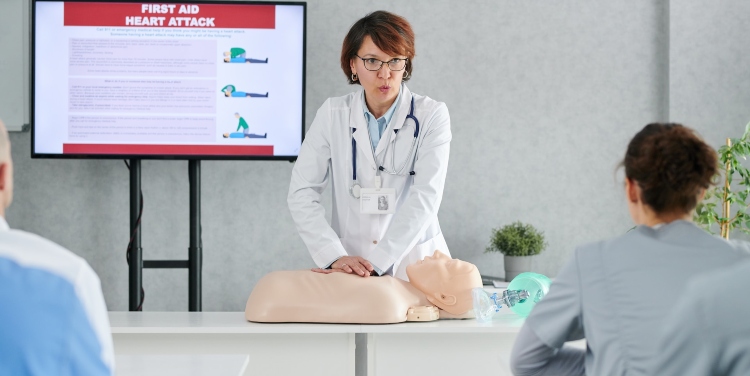Cardiopulmonary resuscitation, commonly known as CPR, is a critical emergency technique employed when an individual’s heartbeat or breathing has ceased. This may occur during various medical emergencies, such as heart attacks or near-drowning incidents. By manually applying chest compressions and rescue breaths, CPR helps maintain blood flow and oxygen supply to vital organs, potentially saving a person’s life until further medical assistance can be provided.
CPR comprises two primary components – hands-only CPR, which consists of continuous chest compressions, and CPR with rescue breaths, incorporating both chest compressions and providing breaths to the unresponsive individual. It is recommended to act quickly and initiate CPR immediately if someone is unconscious and not breathing normally, as every second counts during a life-threatening situation.
The efficacy of CPR can be improved through proper training and technique, enabling bystanders to intervene confidently during crises. Many organisations, such as the NHS and the British Heart Foundation, provide valuable resources and guidance on how to perform CPR effectively, empowering individuals with the knowledge necessary to save lives.
What Does CPR Stand For?
CPR stands for Cardiopulmonary Resuscitation. It is a crucial first aid technique that can help save lives in emergency situations where a person’s heartbeat or breathing has stopped. The main goal of performing CPR is to maintain blood flow and oxygen supply to the brain and other essential organs until further medical help arrives.
CPR involves two main components: chest compressions and rescue breaths. Chest compressions work by applying pressure to the chest to pump blood through the heart and circulate it to the rest of the body. Rescue breaths, on the other hand, are delivered by the rescuer to provide an oxygen supply to the lungs.
CPR can significantly improve the chances of survival when performed on someone in cardiac arrest. Cardiac arrest occurs when the heart stops pumping blood, which halts the oxygen flow to the brain. Without CPR and other first aid, the person may die within minutes.
It is essential to know when to perform CPR. Some situations that might warrant the use of CPR include instances when a person is unconscious, unresponsive, or not breathing normally. In these cases, it is vital to act quickly and call emergency services before starting CPR.
In summary, CPR is a life-saving technique that can significantly improve the chances of survival in emergency situations such as cardiac arrest. Knowing how to perform CPR and identifying when it is necessary can make all the difference in a critical moment.
Brief History of CPR
Cardiopulmonary resuscitation, commonly known as CPR, is a critical life-saving technique that combines chest compressions and artificial ventilation to treat victims of cardiac arrest and restore blood flow to vital organs. The practice has come a long way since its early beginnings and has evolved significantly over time.
In the 16th century, the concept of resuscitation began to take shape, but it was not until the 20th century that the modern form of CPR became widely accepted. In 1963, the American Heart Association (AHA) officially endorsed the idea of CPR. By the 1970s, the global acceptance of the CPR procedures that we would consider “modern” had emerged. The standard technique involved alternating sets of 30 chest compressions and two rescue breaths for adult victims of heart failure.
Over the years, CPR guidelines have been updated to improve techniques and increase the chances of survival for cardiac arrest victims. These updates are informed by ongoing research and advancements in emergency treatment. The current approach focuses on providing high-quality chest compressions and ensuring early defibrillation using automated external defibrillators (AEDs) when necessary.
Today, CPR plays a vital role in saving lives in various situations, such as heart attacks, near drowning, and other instances where normal breathing and circulation have stopped. The practice has become an essential aspect of emergency medical care and first aid training, with countless lives saved thanks to the efforts of trained professionals and bystanders alike.
In conclusion, the history of CPR demonstrates not only the progress of medical science but also the importance of understanding and disseminating life-saving techniques for the betterment of society. As knowledge and technology continue to expand, CPR will undoubtedly evolve further, increasing its efficacy and impact on human lives.
Importance of CPR
Emergency Situations
CPR, or cardiopulmonary resuscitation, is a crucial skill to have in emergency situations. It involves a combination of chest compressions and rescue breaths to help keep a person alive during a cardiac arrest, when their heart has stopped beating effectively. In such situations, every minute counts, and performing CPR can make a significant difference in the outcome. According to the NHS, professionals should apply CPR by placing a hand’s heel on the centre of the chest and pressing down 5-6cm, with a steady rate of 100-120 compressions per minute. After every 30 compressions, give two rescue breaths by tilting the person’s head gently and lifting their chin.
Increasing Survival Rates
The primary goal of CPR is to maintain blood flow and oxygen delivery to the brain and vital organs during a cardiac arrest. Effective and timely CPR can help increase survival rates, as it maintains some blood circulation until more advanced medical care arrives. The British Heart Foundation emphasizes the importance of chest compressions and rescue breaths, pointing out a simple technique to achieve the correct rhythm by pushing to the beat of “Stayin’ Alive.”
Performing CPR as soon as possible is crucial, as the chances of survival decrease with every passing minute. In many cases, bystanders are often the first to react in an emergency, so it is essential for the general public to learn and understand CPR techniques. Additionally, the availability and appropriate use of automated external defibrillators (AEDs) significantly contribute to better survival rates.
In conclusion, CPR’s importance cannot be overstated, as it is a life-saving skill that should be widely taught and practiced. When applied correctly and promptly, CPR can greatly improve a person’s chances of survival during a cardiac arrest and minimize the risk of severe brain damage.
Steps in Performing CPR
Checking Responsiveness
When encountering an unresponsive individual, your first step to perform CPR must be to check their responsiveness. Gently shake the person while asking them if they are okay to determine their consciousness level. If they do not show any response, you should proceed with the CPR process.
Calling for Help
Before initiating CPR, it is crucial to call for help. Dial 999 and inform the emergency services that you are with someone who is unresponsive and not breathing normally. When calling, place the phone on a loudspeaker to effectively communicate with the operator while simultaneously attending to the person in need.
Breathing and Chest Compressions
Once help is on the way, start the process of breathing and chest compressions. Firstly, open the airway by tilting the person’s head back slightly and lifting their chin. Check for normal breathing signs such as the rise and fall of their chest. If there’s no normal breathing, begin chest compressions. Position yourself at the person’s side, placing the heel of one hand in the centre of their chest, and your other hand on top of the first. Interlock your fingers and keep your arms straight.
Begin chest compressions at a rate of 100-120 per minute, pressing down by at least 5cm but no more than 6cm. After 30 compressions, give two rescue breaths if you are trained to do so, or continue with chest compressions only if you are not comfortable with providing rescue breaths. Continue this process until professional help arrives or the person begins to show signs of recovery.
By following these steps, you are providing the person in cardiac arrest with the best possible chance of survival. Remember to stay calm and focused to efficiently execute these life-saving procedures.
CPR for Different Categories of Individuals
Adults
When performing CPR on an adult, it’s crucial to follow the appropriate steps to ensure optimal results. Firstly, place the heel of your hand on the centre of the person’s chest, then place the other hand on top and press down by 5-6cm at a steady rate of 100 to 120 compressions per minute. Then, after every 30 chest compressions, give two rescue breaths (making sure you fully cover their mouth and form a tight seal).
Children
CPR for children aged 1 to puberty follows a slightly different approach. Use one hand for chest compressions with a depth of about 5cm and a compression rate of 100 to 120 compressions per minute. After 30 compressions, administer two rescue breaths, carefully covering the child’s mouth and nose, maintaining a seal. If you’re unable or unwilling to provide rescue breaths, perform continuous chest compressions at the recommended rate.
Infants
For infants under one year of age, use two fingers to perform chest compressions with a depth of around 4cm. Keep the compression rate between 100 and 120 compressions per minute. After 30 compressions, deliver two gentle rescue breaths by covering the infant’s mouth and nose with your mouth. If you’re unable or unwilling to provide rescue breaths, continue with chest compressions only.
CPR Training and Certification
CPR, which stands for CardioPulmonary Resuscitation, is a vital skill that can save lives during emergencies when a person’s heart has stopped pumping blood. To be able to perform CPR effectively, proper training and certification are essential. It is well-known that in case of an emergency a certified first aid person could increase the chances of saving a life while waiting for EMS.
There are numerous courses available which teach CPR techniques to both professionals and the general public. Many ambulance services also offer training to the public, so contacting local services may be a good starting point. The duration and content of these courses may vary, but it is recommended that hands-on practice using a training manikin be included for better understanding of the process.
CPR certificate courses are available for individuals who require the skills to resuscitate unresponsive casualties, but are not required to have a Health and Safety Executive-approved first aid qualification. These courses typically cover essential topics such as chest compressions and rescue breaths. Candidates are expected to have a reasonable command of English language to enrol.
It is important that individuals seeking CPR training ensure they choose a reputable provider. The Resuscitation Council UK is an excellent resource for information on CPR and related training courses.
Regular practice and re-certification are crucial for maintaining competence in CPR. Procedures and guidelines may change over time, so it is necessary for individuals to stay up-to-date and confident in their skills. Proper training and certification can make a significant difference during a life-threatening situation, ensuring that people are well-prepared to provide CPR when it is needed the most.
Research and Development in CPR
Cardiopulmonary resuscitation (CPR) is a vital life-saving technique that has been continuously researched and developed to improve its effectiveness in various situations. The primary goal of CPR is to restore the flow of oxygenated blood to the brain and other vital organs after a person has suffered cardiac arrest. The process involves a combination of chest compressions and rescue breaths to maintain circulation.
In recent years, significant progress has been made in refining the technique and guidelines for CPR. The Resuscitation Council UK plays a critical role in funding and supporting research projects related to resuscitation, with the aim of shaping best practices and improving patient outcomes. Their research not only focuses on refining the techniques but also on other factors that impact the chain of survival, such as bystander response, education, and training.
One important aspect of CPR research is determining the most effective way to train individuals. A study on the impact of cardiopulmonary resuscitation training in schoolchildren examines the optimal age for introducing CPR education and how it affects their ability to perform the skill in real-life situations. This research is crucial as it has the potential to increase the number of trained individuals, ultimately improving the overall survival rates of out-of-hospital cardiac arrests.
Another area of research focuses on the development of innovative tools and technologies to assist in the CPR process. For example, some researchers are investigating the use of mechanical devices that provide consistent chest compressions, while others are exploring the integration of telemedicine and mobile applications to guide bystanders during emergencies. These technological advancements can help improve response times and increase the quality of CPR, ultimately saving more lives.
In conclusion, research and development in CPR continue to play a vital role in enhancing the effectiveness of the technique and expanding its impact. With ongoing studies, technological advancements, and improved training strategies, the future of CPR looks promising for both healthcare professionals and laypeople alike.
Conclusion
Cardiopulmonary resuscitation, commonly known as CPR, is a vital emergency procedure that can help save lives during a cardiac arrest. It combines chest compressions and artificial ventilation to maintain oxygen flow to the brain and preserve brain function until further measures can be taken to restore spontaneous blood circulation and breathing.
CPR is often performed on individuals experiencing emergencies such as heart attacks or near-drowning incidents, making it an essential life-saving skill to learn. The American Heart Association recommends starting CPR with hard and fast chest compressions.
In summary, understanding CPR and its crucial role in emergency situations is valuable knowledge. By administering timely and effective CPR, one can significantly increase the chances of survival for a person in cardiac arrest. Knowing the proper techniques and guidelines can make a life-saving difference during critical moments.
David Prior
David Prior is the editor of Today News, responsible for the overall editorial strategy. He is an NCTJ-qualified journalist with over 20 years’ experience, and is also editor of the award-winning hyperlocal news title Altrincham Today. His LinkedIn profile is here.













































































